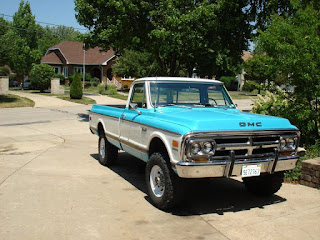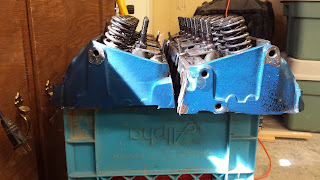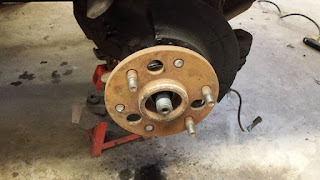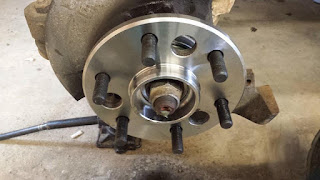If you`re anything like me,it may have taking you a while to add a little safety to your garage,
I always thought that I was being pretty smart when I worked on my vehicles,looking back though..maybe not so much.
I`ve gotten Anti-freeze in my eyes, accidently started a fire using an electric fuel pump, dropped a couple heavy objects due to using the wrong type of chains...well you get the picture. so here`s a few things to think about prior to starting any kind of work on a vehicle or pretty much doing anything in the garage for that matter.
I always thought that I was being pretty smart when I worked on my vehicles,looking back though..maybe not so much.
I`ve gotten Anti-freeze in my eyes, accidently started a fire using an electric fuel pump, dropped a couple heavy objects due to using the wrong type of chains...well you get the picture. so here`s a few things to think about prior to starting any kind of work on a vehicle or pretty much doing anything in the garage for that matter.
- Don't count on a jack,always use jack stands that are rated for the weight of the vehicle.
- If you're loosening really tight lug nut,get them cracked before jacking the vehicle up.
- Properly block your vehicle from rolling when lifting one end or the other.
- Don't be taking of the rad cap when the engine is hot. Same goes for draining oil,even though they never let the engine cool down when you go into a Minute Lube,that doesn't mean its safe to do.
- When your working on your brakes,stay well away from the cancer causing agents that make up part of your brake pad and shoe linings. This goes for clutch discs too! Here's a hint of one of the products,Asbestos!
- When using a wrench,always try to pull towards you. Unless it is open enough on the opposite side to push the tool without you scraping or cutting your knuckles.
- Use the right tool for the job.
- Use proper drain pans that will hold as much fluid as you need them too when you are draining them.
- Use safety glasses and hearing protection. Take it from a guy that's half deaf and had to flush his eyes out lots of times and has a hard time hearing what the wife is sayin.
- Label everything! Even if you are they only one that works in your shop. You never know when your kid is going to think that old anit-freeze tastes like liqourice.
- If you have young children, make sure your paints and cleaners are in a cabinet they can't get into.
- Keep a bottle of peroxide in your shops first aid kit in case your family dog had a taste of that anti-freeze in the drain pan on the floor.( Small dog= 1 table spoon,medium and larger breeds 2 table spoons) Let them puke it out and then call a vet. (Don't do this with your kids call the hospital!)
- Get a buddy to help lift that 5 speed transmission onto the bench,or anything else that weighs more than you do. Once back issues start,they have a habit of coming with a lifetime guarantee!
- We all know you`re smart enough to not have loose clothing on when it can get caught up in anything that spins fast..electirc fans,fan belts,alternators..and so forth.
- Never ever rush a job! Take the time to do whatever it is that you are doing right. The safe operation of your vehicle is priority number 1,if your vehicle is un-safe as a result of your work it effects everyone on the road with you. That includes the safety of your family.
Steering,Brakes and Your Front End.
If you have never worked on any of these systems of your vehicle then find out all you can about them. Rule number one for me,the second thing I buy after I`ve bought a vehicle is to go down to the local parts store and buy the manual they sell for it. Having fasteners left over after you`ve installed new brake pads would tell you there`s something wrong. If you need one,click here. You may have to search a bit but,its well worth it.
Airbags
These safety features on your vehicle are in essence explosive actuated devices. Make sure you`ve gotten all the info you need to properly dis-able your vehicles airbags while you are working on them,one of the reason`s why they recommend that you remove the negative battery cable from your battery prior to working on your vehicle is to prevent the airbag from punching you in the face at the wrong time.
Asbestos
Contrary to what most people think (and I say think cause the majority doesn`t know any better) every vehicle on the road has cancer causing asbestos integrated into various parts on a vehicle,disc and drum brakes, clutches just to name a few. Use a mask when working on these parts and avoid the dust!
Fire Prevention
Remember that I mentioned fire before? Well let me tell you, a gasoline fed fire spreads very fast! I blew through 2 30 pound fire extinguishers putting out a fire I started by not using my head. At the very least one Dry Chemical fire extinguisher at each entryway into the garage or one very handy if you are in the driveway.
Remember, any device that uses radio frequencies,cell phones,2 way radios and the like, create static electricity and can cause a fire under the right conditions. If you have gas in a container with no lid on it then vapors are present. I watched a guy set fire to his work truck on morning when he was talking on his phone. There's a reason that sign means "NO Cell Phones". Anything that can cause a spark can start a fire if there's vapors present.
Fumes
There's a reason that cleaning product come with what's called an MSDS or Materials Safety Data Sheet. These wonders of modern technology tell us some very important information when it comes to proper use. Reactions, LEL (lower explosive limit), UEL (upper explosive limit) and proper handling techniques just to name a few. These products sometimes create toxic fumes. Make sure you wear the proper masks and have ventilation when required when you use these products.
If you use a little due diligence your project will turn out exactly how it was supposed to and you'll get to live to tell about it. I've seen natural selection come into play through out the years and its never pretty. At the very least,make sure your first aid kit is up to date and is adequately stocked.










